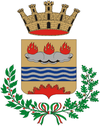Eboli (Campania)
| Eboli | ||
|---|---|---|

|
|
|
| Country | Italy | |
| region | Campania | |
| province | Salerno (SA) | |
| Coordinates | 40 ° 37 ' N , 15 ° 3' E | |
| height | 145 m slm | |
| surface | 138.7 km² | |
| Residents | 39,442 (Dec. 31, 2019) | |
| Population density | 284 inhabitants / km² | |
| Post Code | 84025; 84020 (frazione di Santa Cecilia) | |
| prefix | 0828 | |
| ISTAT number | 065050 | |
| Popular name | Ebolitani | |
| Patron saint | San Vito | |
| Website | Eboli | |
Eboli is a town with 39,442 inhabitants (as of December 31, 2019) in Campania ( Italy ), in the province of Salerno , on the south side of the Sele Valley.
Eboli is known as an agricultural center, primarily for its olive oil and dairy products , especially the mozzarella di Bufala Campana .
history
The first traces of settlement go back to the Neolithic . Archaeological excavations have shown that the area around Eboli was inhabited since the Copper and Bronze Ages and dates back to the 5th century BC. There are references to connections to the Villanova culture . The ancient Eburum was a Lukan city, mentioned only by Pliny the Elder and in inscriptions, and which was not far from the Campanian border. This ran above the Via Popilia , where there is now a railway line. To this day there are scattered remains of Roman installations and border walls. In 410 AD, with the fall of the Roman Empire , the city was destroyed for the first time by the forces of Alaric . Further destruction and looting took place in the 9th and 10th centuries through raids by the Saracens .
Attractions
- San Francesco, former Franciscan monastery from the 14th century. The sacristy of the church contained two paintings from the 14th century, one of which was done by Roberto d'Oderisio (around 1335 - after 1382) of Naples . Today it is kept in the Diocesan Museum of Salerno .
- San Pietro alli Marmi , Romanesque three-aisled basilica from the 12th century
- Sanctuary of Saints Cosmas and Damian. The church dates back to a building from the 11th century, was damaged several times in the course of history, rebuilt and expanded, fundamentally in the Baroque era. The interior is richly decorated with wall paintings and mosaics and contains an Immaculata from the 17th century by Giovanni Bernardo Lama (1508–1576) and an entombment of a Sicilian artist from the 18th century.
- Roman brick factory from the 2nd – 4th centuries Century BC, in the garden of the sanctuary of Saints Cosmas and Damian
- Roman aqueduct at Montedoro di Eboli, area of ancient Eboli
- In the city there are a number of representative palaces from the 16th to the 19th century, but they were badly damaged in the catastrophic earthquake in Irpina .
sons and daughters of the town
- Pietro da Eboli († 1220), poet, chronicler and doctor
- Matteo Ripa (1682–1746), missionary to China, orientalist and painter
- Thomas Eboli (1911–1972), Mafiosi and head of the New York Genovese family
- Domenico Caso (* 1954), soccer player and coach
- Emanuele Belardi (* 1977), football player
- Persons connected to Eboli
- Ana de Mendoza y de la Cerda , Princess Eboli, was married to Ruy Gómez de Silva, Prince of Eboli (1516–1573). She was maid of honor to the Queen of Spain and is a character in Friedrich Schiller's drama Don Karlos .
Christ only came to Eboli
Christ only came to Eboli ( Cristo si è fermato a Eboli ) is an autobiographical novel by the Italian author Carlo Levi about his exile in Lucania . The title is a quote from a local saying. The novel deals in detail with the desolate social conditions and the backwardness of the population in the remote mountain villages. In 1979 Francesco Rosi filmed the book under the same title with Gian Maria Volonté in the role of Carlo Levi.
Individual evidence
- ↑ Statistiche demografiche ISTAT. Monthly population statistics of the Istituto Nazionale di Statistica , as of December 31 of 2019.


